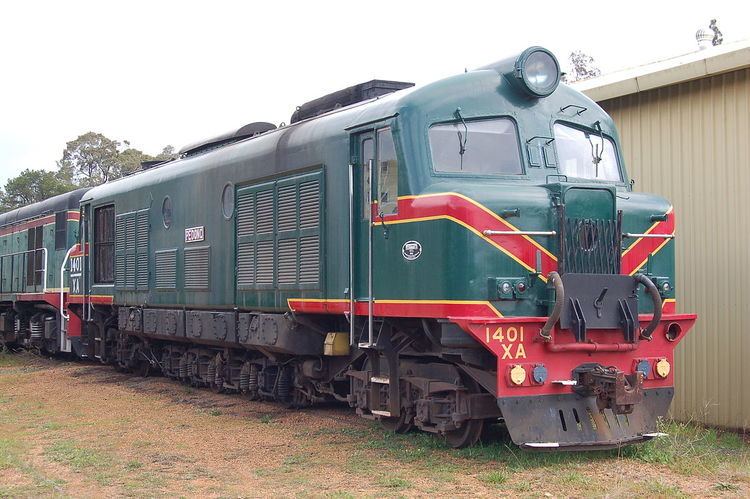Build date 1954-56 AAR wheel arr. (?) | Serial number 830-877 Total produced 48 | |
 | ||
The X class was a class of diesel locomotives built by Beyer, Peacock and Company and Metropolitan-Vickers, Bowesfield Works, Stockton-on-Tees for the Western Australian Government Railways between 1954 and 1956.
Contents
Construction
In the early 1950s the Western Australian Government Railways placed the largest single Australian order for diesel locomotives, when it ordered 48 2-Do-2 locomotives from Beyer, Peacock and Company and Metropolitan-Vickers. All were delivered between 1954 and 1956.
Operation
The X class revolutionised operations on the WAGR. Their light axle load (around 12t) meant they could travel on all lines. The dual cab arrangement eliminated the need for turning. They were quickly allocated to express passenger trains including the Albany Express, Australind, Kalgoorlie Express and The Westland.
The Crossley Engine
At the time of construction, the HST-Vee8 was an untested concept, though the engine itself was an evolution of a design used successfully in patrol boats during World War Two. Failures commenced within weeks of the first locomotives being unveiled. It was only the skill of staff at WAGR's Midland Railway Workshops that saved the day. In their early days, availability was less than for steam.
The engines used exhaust pulse pressure charging and developed 1,200 horsepower (895 kW) at 625 rpm, though in 1981 they were down-rated to 875 hp@600rpm. There were no valves, and inlet and exhaust were via ports in the cylinder walls.
The engines burnt oil, had underfed bearings, vibrated and popped heads and pistons, and suffered from ring scuffing for most of their lives. It was only the engineering excellence, and perseverance of Midland Railway Workshops staff that kept the locomotives operating, and performance improving. In the end, over 600 design faults, mainly in the Crossley engine, were overcome.
Rumours persist suggesting the engine was either war surplus, or formerly from a sub maritime application. Neither of these are correct, despite some publications suggesting this. The myth may arise from Crossleys success in delivering robust engines for marine and other modes of transport.Interestingly, it has been noted that the Irish Railways (CIÉ), through the respected Engineer Oliver Bulleid, had "heard" through the British Admiralty that the "Crossley unit gave no trouble".
The Smith Royal Commission into the class identified blind faith in the British, and chided the WAGR for ignoring the advice of supervising engineers in the UK, who reported problems with the traction motor during testing. Whilst Córas Iompair Éireann re-powered its Crossley powered locomotives to rid themselves of the problem, The Smith Royal Commission recommended against this, and proposed the class be replaced.To be fair to the WAGR, it was not the only one that rushed into buying unproven traction. BR did so, buying many locomotives in its rush to dieselise that did little to improve its bottom line, including purchasing the disastrous Co-Bo Class 28 cousins
Multiple unit working
During construction, 16 locomotives were fitted with multiple unit control and denoted the XA class. These locomotives included communication doors at each end. The 16 XA's were numbered as a separate block to the X/Xb's, starting with class number 1401.
From December 1963, Midland Workshops fitted 10 Xs for multiple unit working, these were reclassified as the Xb Class. The Xb were not fitted with communication doors but did retain their original 10XX classification numbers.
Other Modifications
Whilst the class were built with locomotive air braking and train vacuum braking systems, during 1969 and 1970 8 of the XA's were modified to operate with dual vacuum/air braking systems manufactured by Davies Metcalf to allow them to operate air braked salt traffic on the Esperance Branch. This equipment was removed in the early 1980s, only to be reinstalled in XA1406 (October 1986) and XA1403 (November 1986) to allow these units to haul ex-QR coaches on suburban services.
End of Career
In their final years, those still in service were reputed to have performed well. They ran grain trains in the South West as late as 1984, and provided power for trains following the reopening of the Fremantle line up to the last retirement (XA1402) in 1988.
The first were withdrawn in 1973, primarily as sources of spare parts. The last was withdrawn on 31 March 1988.
Names
The locomotives carried the names of tribes, tribal leaders and warriors from around Australia. Within the WAGR. proposals were made to code the class as "T", and for the class to be known as the "tribal class". This was not adopted. However, confusion at the time resulted in duplications and incorrect spellings.
Within the WAGR, the class earnt the nickname "Hummingbirds".
Status list
The 48 locomotives were:
Preservation
One X class and five XA class locomotives have been preserved:
